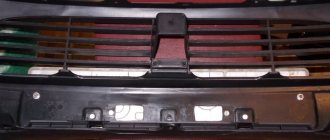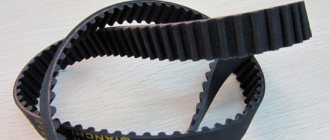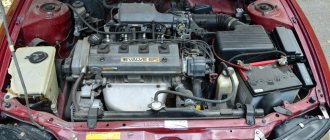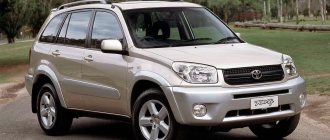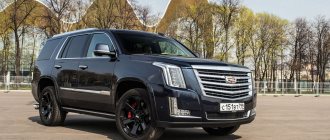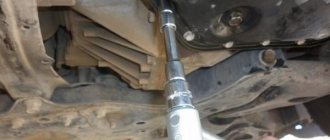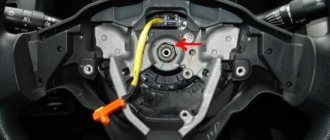3808 Apr 20
The most popular Japanese-made car on the domestic market is the 2007 Toyota Corolla model representing the middle C segment, the release of which marked the release of the new E150 body.
Toyota Corolla of the Year 2007 in the E150 body from the very beginning of production began to be in great demand in the domestic market, whose car enthusiasts gave their preference to a reliable Japanese-made car, which also has a good range of configuration options and the performance properties of modern options that can ensure increased safety for the driver and everyone passengers.
Technical equipment with power units and transmission options
The 2007 model received a new line of power units with an upgraded Dual VVT-i gas distribution system, the technical characteristics of which have the following indicators:
- 4 engine displacement, gasoline, 4 cylinders in a row, pistons 72.5 mm in diameter with a stroke of 80.5 mm and a compression ratio of 11.5:1. Engine power is 97 “horses” or 74 kW at 6000 rpm with a maximum torque of 132 Nm, achieved at 3800 rpm. The fuel consumption officially declared by the manufacturer is 7.3 liters in urban mode with the emission of 172 g/km of CO2 gases into the air; in extraurban mode, the consumption is 4.9 liters, CO2 emissions are 116 g/km; in mixed mode, 5.8 liters of fuel are needed, and 136 CO2 are emitted g/km.
- 6 engine displacement, gasoline, 4 cylinders in a row, pistons 78.5 mm in diameter, their stroke is 80.5 mm with a compression ratio of 10.2:1. Engine power is 124 “horses” or 91 kW at 6000 rpm with a maximum torque of 157 Nm, achieved at 5200 rpm. The fuel consumption officially declared by the manufacturer is 8.9 liters in urban mode with the emission of 208 g/km of CO2 gases into the air, in suburban mode the consumption is 5.8 liters with CO2 emissions of 137 g/km, in mixed mode the fuel consumption is 6.9 liters and the emission of CO2 gases is 163 g/km.
The fuel intended for the 2007 Corolla must comply with the Euro 4 standard and have an octane rating of 95 or higher, which can significantly extend the service life of fuel system parts.
Each engine is paired with a manual gearbox with six gears, or a robotic gearbox with a double clutch and six steps. The dynamic performance of the car is as follows:
- 1.3 engine, manual transmission, accelerates to hundreds in 13.1 seconds, maximum speed is 180 km/h;
- for a 1.6 engine with manual transmission, this speed will be reached in 10.4 seconds, and the maximum is 192 km/h;
- 1.6 engine, robot gearbox will accelerate the car to hundreds in 11.9 seconds and reach a maximum speed of 183 km/h.
One of the main disadvantages of the car in the E150 body was the robotic transmission, the operation of the mechanism of which often did not allow the car to display all its dynamic performance without timely shifting gears. She broke down pretty quickly.
The subsequent update of this car, which took place in 2010, brought significant changes to the transmission. The manufacturer replaced the robot, which caused complaints from car owners, with a classic six-speed automatic, which significantly increased the popularity of the restyled model.
After replacing the robot with a classic automatic, the car began to accelerate to hundreds more dynamically and received stable operation of the entire transmission, which is included in the maximum configurations of Elegance and Prestige.
Toyota Corolla 2007: disadvantages and features of the transmission
The disadvantages of the Toyota Corolla manual transmission include low reliability and short service life. They are caused by unsatisfactory operation of the actuators and the control unit.
As evidenced by reviews of the 2007 Corolla robot, with a normally operating system (with a new type ECU), the clutch kit wears out after 100 thousand km.
This may be caused by an incorrect process of disk convergence, frequent under-reduction mode, or soft gear engagement due to slipping of the linings. The ECU is not yet able to simulate maintaining the correct gas-clutch balance, which leads to premature wear.
The main defect of the actuator is the bushings in which the shaft rotates.
Thus, for normal operation of the Toyota Corolla 2007 transmission, it is advisable to:
- Replace the old control unit with a new type ECU.
- Upgrade and repair actuators.
- You may need to replace the motor brushes or the motor itself.
- Replace the bushings with bearings (a shaft worn out in the seats cannot be inserted into the bearings).
- Replace clutch kit.
- Go through the adaptation procedure.
It is better to do all this at once, then initialization will only be needed once.
To confirm the owner's opinion.
Toyota Corolla 2007 transmission features
Suspension and braking system
The front suspension of the car is a classic independent version of MacPherson struts, lower arms with a transverse stabilizer bar and is one of the most reliable units in the entire structure. The rear suspension of the car is a semi-independent spring type with a transverse beam, the mobility of which is ensured by torsion silent blocks.
The braking system, unlike the previous generation, where drums were installed at the rear, is completely disc in the E150. The front part is equipped with ventilated discs measuring 275x22 mm, and the rear is equipped with non-ventilated discs measuring 259x9 mm. Active electronic assistants ABS, EBD and BAS allow you to avoid all possible skidding during emergency braking, which has significantly increased the safety of the car.
Exterior and interior
A review of the updated E150 body showed that the manufacturer did not make any noticeable changes in the quality of interior finishing materials, limiting itself to improving the dashboard. He placed an on-board computer display in it and equipped the center console with a new multimedia system that supports wireless connection via Bluetooth and works in navigator mode, as an option for expensive trim levels.
The increased overall dimensions of the body of the updated modification of the Corolla made it possible to increase the trunk volume, which became 450 liters, and added free space for rear row passengers. Its shortage caused significant complaints from car owners.
The overall dimensions of the E150 sedan have the following dimensions (in mm):
- machine length – 4540;
- car width – 1760;
- height is 1470;
- wheelbase is 2600;
- front track parameters – 1520;
- rear track parameters – 1525;
- ground clearance - 150;
- weight of the equipped car in kg – 1300.
The standard tire and wheel sizes are 205/55 and R16, respectively.
Review of Toyota Corolla 1.6 (2007)
Good afternoon. I want to tell you about my 5-year experience of owning this car. I won’t describe the agony of choice and how I came to this. I'll tell you about the car right away. I bought a Corolla in 2007. They just started selling it. Joy, delight. On the street it attracts attention (it’s a new model after all) + the color is gorgeous (my personal opinion). Then the joy began to fade with each stop of the valiant traffic police workers. At first I thought that they just wanted to see the car, but they looked more at the documents. It really starts to get stressful - if they see you somewhere on the road or at a checkpoint, they will definitely slow down. The reason for so much attention to my car became clear after 2 weeks. It turns out that such a car was stolen, and it was in blue color. Since at that time there were not many such cars, and even blue ones, every oncoming traffic slowed me down. This is the other side of the coin for you.
Now more details about everything:
Body.
Comparing with the Lancer (the one with 9) - heaven and earth. The Corolla was scratched by literally everything. I washed the Lancer (since it was a worker) 3 times a week. Corolla - about once a week. At the time of the sale of the latter, in terms of paintwork condition, it was clearly inferior to its friend. Here, of course, you need to take into account the color of these cars, because... The Lancer was light green in color. …..but still. Appearance - it depends on everyone, everyone has seen it, everyone knows it.
Engine.
The 1.6 engine of the Corolla is quite enough. A reasonable compromise between dynamics and efficiency. On-board computer showed 8.9. The checks confirmed this. When selling the car, the buyer drove it to a service station with his friends. Summary - the engine is the most alive. Considering that maintenance is required every 10,000, this is quite predictable.
Suspension.
The suspension, it seems to me, is a bit harsh. On the same Lancer it is softer. For the highway this is, of course, good, but in the city it is already a minus. But she is indestructible. For 105,000 km I didn’t do anything to it at all. A pre-sale inspection by the same craftsmen only showed an emerging problem with the rubber bands. Everything else is normal.
Box.
This is where the weak point of this model lies. The Japanese decided to test their innovations on the residents of Russia; fortunately, they supplied them to Europe with a machine gun. Besides Russia, this miracle robot was delivered somewhere else, but I won’t tell you where such Corollas and Auris were sold. The idea with a robotic gearbox is great: the dynamics and consumption are like a manual, yet it’s as convenient as an automatic transmission. There is an automatic mode (when the gearbox itself switches gears), there is a manual mode (shifting gears using the steering wheel paddles). But in reality it turned out not to be so. The robot (official name: MultiModeTransmission) was stupid with switching, there was no smooth operation. Since the gearbox was “adapted” to the driver, after my wife’s trips I couldn’t drive a Toyota. She drives calmly, I am more active. And so I get into the car, drive out onto the street, drive in traffic, start accelerating moderately and bang.....the robot puts into the next gear and there is no more acceleration. Crap! I press the gas harder…….nothing…..even harder……and then suddenly…..the burenka seems to be getting a whip in the ass, and jumping up 2 gears starts to accelerate sharply. “№;%:?*:88*$^:!!!!!!!!!! What is this???? Drivers prefer to give way because they believe that the driver is inappropriate. Subsequently, for the first hours after my wife, I drove in manual mode in order to exclude such “fun”. It was also infuriating when the robot stubbornly refused to turn on speed 2. The steering column switches saved the day. They could even force the speed switch in automatic mode. Having read everything I could about this box, I tried to drive as the manufacturer prescribed. I moved the lever at traffic lights to position N and periodically calibrated the MMT. When changing gears, I took my foot off the gas. The trick is that the MMT is the same manual transmission, only the speeds are switched by 2 drives. One turns the clutch on/off, the second switches gears. Accordingly, you need to treat this box not as an automatic, but as a manual transmission. By these actions I extended the life of the clutch to 85,000 km. Although many people changed it already at 50,000. In 3 years, they changed the initialization unit (free of charge, under warranty). They changed it not because the previous one was broken, but because this block is responsible for the operation of the MMT and the Japanese tried to improve this very operation of the box with modified blocks. Such a block costs 30 thousand rubles. I was looking at existentialism then. Shall I say what happened? Nope. Although with the last block the car drove much better than with the first.
The cost of replacing the clutch at the dealer is 32,000 rubles. This takes into account discounts on work and salary. The clutch alone cost 15,000 rubles. I ordered from a well-known online store for 7200. After a lot of wandering around the service station (as soon as they found out that I had a robot they immediately refused) I turned to a friend. The whole point is that the clutch itself changes in exactly the same way as on a manual transmission. Actually this is the same clutch. The catch is that after replacement you need to initialize the clutch. Otherwise the car will think that the clutch is old. The point is long to explain. In short, if this is not done, the car will quickly burn out the new clutch. Initialization is done in 5 minutes using a connected scan with the appropriate software. Only the dealer has this software. At least I couldn't find anyone else. After climbing all the forums, I downloaded those. documentation for office workers dealer. In this documentation I found how to carry out initialization WITHOUT the help of a scanner. It was necessary to stupidly perform a series of sequential actions. That's what it was written in those documents, they say this is a method in case it is not possible to connect a scanner. Result: 7200 clutch with release bearing + 7800 work + 200 rubles drinking beer directly at a garage-type service station. By the way, a mechanic I knew had a scanner and even had software for Toyota, but with the help of this program. We were never able to initialize the software (it simply did not have such a function).
Salon.
The salon is well made. The steering wheel is pleasant to the touch. Ergonomics are very good. Everything is at hand. The plastic is not bad. In 5 years, no crickets seem to have appeared in the torpedo. Although I don't remember anymore. Instrument panel - optitron. Looks impressive. The only irritating thing was the fuel display in the tank. Not analogue, but stupid cubes. It is difficult to determine the exact quantity. The music is so-so. Middle peasant. But I can only say positive emotions about the climate control system. The Camry works worse. The front seats are comfortable. I won’t say anything about the rear ones - I haven’t driven there. The trunk is large, but the volume is increased due to the rear sofa (there is less legroom for rear passengers than in the Lancer). The picture is also spoiled by the narrow opening between the rear sofa and the trunk. Accordingly, an oversized item, even if it extends along the length, will not fit in height. In the same Lancer I carried larger items. Although it has a smaller trunk volume, there is no such limitation due to the opening. In short, you will take away more travel bags in the Burenka, but I only took the exercise machine in the box from the store with the Samurai.
The glove compartment is large. For those especially in need there is a glove compartment. There are niches throughout the cabin for every little thing. Yes, I forgot to say that the seat upholstery is easy to wash and clean. This is definitely a plus.
The quality of sound insulation is as befits this class. I would like it to be better, but it’s quite bearable as it is.
Peculiarities.
Pad wear. I set a personal record with this car - 50,000 km. During the entire period of operation, I changed them 2 times: To-50 at the dealer and to To-100 myself. Moreover, the wear of the rear pads does not occur evenly over the entire plane, but at an angle. As I found out this is the norm for this model. Connected to the handbrake, which pulls itself up. I could be wrong, but that's what I was told. Another nuance when replacing pads: the rear caliper is not pressed back, but twisted. A special key (clover-shaped). It was an unpleasant surprise for me. I tightened it using mats and an open-end wrench (I don’t remember the size). Such a long life of the pads is explained by the fact that the robot, when you press the brake pedal, does not reset the speed to neutral, but alternately shifts gears from the highest to the bottom (in other words, it brakes with the engine). In the latest version of the initialization block, they tried to minimize this effect, i.e. The robot started shifting down gears at about 2000 rpm (previously it was about 3000 rpm).
Ambient temperature sensor air. It is installed behind the lower bumper grille. Next to the radiator. The mount is no good (weak plastic). For me it broke off from a simple pebble that flew into it through the grate. I didn't notice this right away. I noticed that the climate control somehow began to work inadequately. It was cold in the cabin. I had to turn up the temperature all the time. I made an appointment with the dealer. Had arrived. Half an hour later they called me. We approached the car. He shows me the reason - the air temperature sensor is hanging on the wire. This notorious sensor is tied to climate. When setting the temperature in the cabin, the computer is guided by this sensor (in addition to the cabin temperature). At speed, the long-suffering sensor was pressed against the radiator and it began to lie (by about 5-7 degrees). Accordingly, the computer thought that the street had suddenly become warmer and supplied colder air into the cabin. It seems like some kind of nonsense, but it’s really so. The mount, as it turned out at the dealer, comes with the sensor and costs 4000!!!!! rubles Shocked by such prices, I went home and already at home I attached it into place using a clamp for 2 rubles. I ordered an original sensor via the Internet along with a mount for 700 =) rubles. In the garage, having removed part of the lower plastic protection, I installed it in 15 minutes. I didn’t go to the dealer because... They said that to do this you need to remove the bumper. O_o I’m afraid to imagine how much it would cost them.
A friend had the same situation. All with the same stone (or something similar). He also went to the dealer first. Swelling from such price tags. When we met, he accidentally asked me. When I learned about the solution to this problem, I happily ran to order a sensor from the store. A week later, I helped him set it all up, and in the evening he came with a human “thank you” and a bottle of good cognac. By the way, after replacing the sensor, the climate control began to work as expected. So that's how things are.
LCP. As I wrote above, it scratches very easily. After 5 years the car was covered in small scratches. Despite the fact that I tried to keep an eye on the body. I thought about going to polish it, but the buyer decided to do it himself.
Candles. On the Corolla they are iridium and are changed every 90,000 km. To change them you need a special candle holder, because... they are located deep inside the block head. After the story with the sensor, I didn’t even think about the dealer. I solved the problem this way: I took 2 heads (I don’t remember how many), boiled them in a circle, ground off the protruding edges and wrapped the junction of the heads in one layer of electrical tape. The time spent was about 30 minutes. Another 10 were needed to replace the spark plugs. As the inspection showed, another 10 thousand old spark plugs would have easily gone away.
Fuel filter. According to the regulations, it changes at 90,000 km. However, you won’t buy the filter itself; it comes complete with a pump and costs from 3.5 k rubles. On the forums people write that they do not change until 120,000. In short, I ordered it in the store for TO-100. In general, if the fuel is good, then I think you can drive up to 130,000 km.
And finally.
You can easily service the car yourself. Which I personally became convinced of after the warranty period expired. The main thing is not to be afraid. The car is reliable (MMT doesn’t count), but without any special features (the same Lancer really stuck with me). Even taking into account this terrible robot, the car has never let me down. I read on the forum that for some people the car did not start in the heat (about 37). We don’t have such temperatures in St. Petersburg, but in hot and cold weather mine started without problems. The car is feminine. Toyota Corolla three times female. You just need to know how to start it. =)
Thanks to everyone who mastered it. I wanted to convey as much information as possible. Maybe it will be useful to someone.
